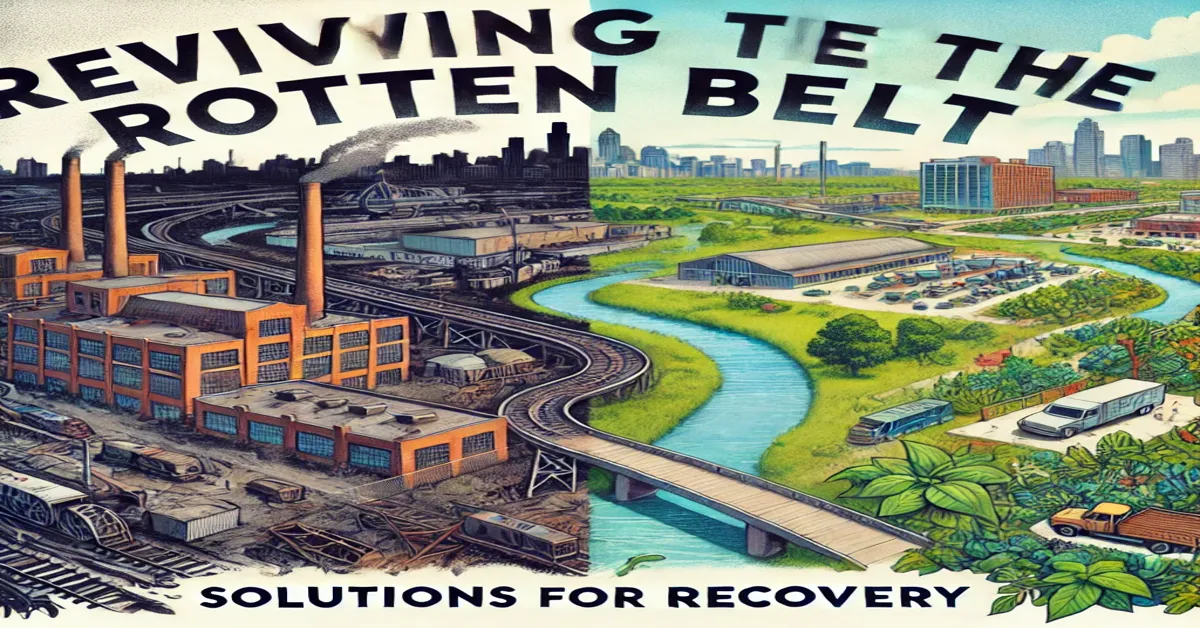The “rotten belt” may sound like a fictional term from a dystopian novel, but it’s a real issue with wide-reaching implications. The phrase is often used to describe areas affected by decaying infrastructure, failing industries, and socioeconomic decline. This concept encompasses regions where once-thriving economies have been decimated due to a variety of factors such as deindustrialization, environmental degradation, and mismanagement of resources. Understanding the causes and consequences of the rotten belt is crucial for addressing its challenges and finding sustainable solutions.
In this comprehensive guide, we will dive into the meaning behind the rotten belt, its root causes, the impacts it has on communities and economies, and the potential paths toward revitalization. We will also explore how governments, businesses, and individuals can work together to transform these regions into thriving, sustainable areas once again.
What is the Rotten Belt?
The term “rotten belt” can be used in several contexts, but it is primarily associated with regions that have experienced a significant decline in industrial productivity, economic growth, and quality of life. These areas are often characterized by crumbling infrastructure, abandoned buildings, high unemployment rates, and rising poverty. Typically, regions that once relied heavily on industries such as manufacturing, mining, and steel production fall into this category when those industries either collapse or relocate.
The phrase draws a parallel to the more commonly known “Rust Belt” in the United States, where deindustrialization and economic shifts in the late 20th century led to massive job losses and urban decay. However, the “rotten belt” may also refer to agricultural zones where soil fertility has declined, causing crops to fail and economies to crumble, or urban areas where mismanagement and neglect have caused the deterioration of essential services and infrastructure.
Historical Context
Many regions across the globe have experienced periods of economic prosperity followed by steep decline due to factors like technological advancements, globalization, and environmental degradation. The rotten belt is a testament to how quickly fortunes can change for a region that was once a major player in its country’s economy.
Key Characteristics of the Rotten Belt:
- Economic Decline: A marked downturn in the industries that once drove the economy.
- Unemployment: High rates of joblessness as a result of factory closures or the relocation of industries.
- Urban Decay: Deteriorating infrastructure, abandoned buildings, and shrinking populations.
- Environmental Damage: In some cases, pollution and poor land management contribute to the decline.
Causes of the Rotten Belt
Understanding the root causes of the rotten belt is essential for creating effective solutions. These causes can vary depending on the specific region, but they often fall into several broad categories.
1. Deindustrialization
Deindustrialization occurs when major industries relocate or shut down entirely, leading to mass unemployment and economic decline. This has been a common issue in the United States, particularly in the Rust Belt. As manufacturing jobs moved overseas to countries with lower labor costs, cities that were once hubs of industry, such as Detroit, Cleveland, and Pittsburgh, fell into economic hardship.
Globalization has accelerated this process, as companies seek cheaper production costs abroad. The shift from an industrial economy to a service-oriented one has also left many blue-collar workers without job prospects, leading to widespread unemployment and socioeconomic problems.
2. Automation and Technological Advancements
While technological innovation can drive economic growth, it can also lead to significant job losses in industries that rely on manual labor. Automation has replaced countless jobs in manufacturing, mining, and other industrial sectors, contributing to the decline of regions dependent on these industries.
While automation can increase efficiency, it leaves behind workers who lack the skills required to transition into new jobs in the technology or service sectors. Without adequate retraining and education programs, these workers become part of the growing unemployed population, further contributing to the rotten belt’s decline.
3. Environmental Degradation
In some cases, environmental factors play a significant role in the development of a rotten belt. Industrial pollution, deforestation, and poor land management can render large areas unsuitable for habitation or agriculture, causing entire communities to collapse. This is particularly true in regions where mining, oil extraction, or heavy manufacturing have left behind toxic waste and degraded ecosystems.
In agricultural areas, poor soil management, deforestation, and overgrazing can lead to the creation of a “rotten belt” where land becomes unproductive and entire economies dependent on farming collapse. Examples include parts of the Dust Bowl in the United States during the 1930s or modern-day regions affected by desertification in Africa and Asia.
4. Urban Mismanagement and Neglect
Corruption, poor urban planning, and mismanagement of public resources can contribute to the decay of infrastructure and public services. Cities that fail to maintain their infrastructure—such as roads, bridges, public transit, and sanitation—can quickly fall into disrepair, creating environments that are unsafe and unattractive for both businesses and residents.
Urban decay also feeds into a vicious cycle of depopulation, where residents flee crumbling neighborhoods, leading to further declines in property values and a shrinking tax base. This, in turn, reduces the city’s ability to invest in improvements, deepening the region’s economic troubles.
5. Globalization and Trade Policies
Global trade agreements and the outsourcing of jobs to countries with lower labor costs have had a profound impact on industries in developed nations. While globalization has created opportunities for many businesses, it has also left behind regions that were once heavily dependent on manufacturing. Industries that couldn’t compete with cheaper foreign labor either moved operations overseas or shut down completely, leaving behind massive unemployment and economic stagnation in their wake.
Trade policies that favor foreign production over domestic manufacturing can exacerbate these issues, making it difficult for former industrial powerhouses to recover from the economic blow.
Consequences of the Rotten Belt
The decline of once-thriving regions has far-reaching consequences, not just for the individuals and communities directly affected, but also for the broader economy and society. Here are some of the key impacts:
1. Unemployment and Poverty
High unemployment rates are one of the most immediate and visible consequences of the rotten belt. As industries shut down or relocate, workers are left without jobs, often with few prospects for finding new employment in their region. This leads to increased poverty, food insecurity, and reliance on government assistance.
The loss of jobs also has a ripple effect on the local economy. Businesses that once depended on workers’ disposable income—such as restaurants, retailers, and entertainment venues—see their revenues decline, leading to more closures and layoffs. This creates a vicious cycle of economic decline that is difficult to reverse.
2. Population Decline and Urban Decay
As unemployment rises and quality of life declines, many residents choose to leave the region in search of better opportunities elsewhere. This depopulation contributes to urban decay, as abandoned homes, businesses, and industrial sites are left to deteriorate.
A shrinking population also means a shrinking tax base, making it even harder for local governments to invest in infrastructure improvements or social services. In some cases, entire cities or towns may become “ghost towns,” with only a small fraction of their former population remaining.
3. Crime and Social Instability
Regions affected by economic decline often experience higher rates of crime and social unrest. Poverty, unemployment, and lack of opportunity can lead to increased rates of theft, drug use, and violence. Without adequate funding for police, social services, and rehabilitation programs, local governments struggle to address these issues, leading to further instability.
4. Health and Environmental Concerns
The rotten belt is often associated with poor environmental conditions, particularly in regions where heavy industry once dominated. Polluted air, water, and soil can lead to a host of health problems for residents, including respiratory issues, cancer, and other chronic illnesses. In some cases, the environmental damage is so severe that it poses long-term risks to the health of the population and the viability of the region as a place to live and work.
Moreover, the decline in public services can lead to inadequate healthcare, poor sanitation, and limited access to clean water, exacerbating the health issues faced by residents in the rotten belt.
5. Loss of Cultural and Social Identity
For many communities, the industries that once drove their local economies were also central to their cultural and social identity. The loss of these industries can leave residents feeling disconnected from their roots and unsure about the future of their community. The closure of factories, mines, or steel mills often represents more than just the loss of jobs—it can symbolize the end of a way of life that has been passed down through generations.
Solutions for Revitalizing the Rotten Belt
Despite the challenges, there are solutions for revitalizing regions affected by the rotten belt. A combination of government intervention, private investment, and community engagement is necessary to turn these regions around.
1. Investment in Infrastructure
Revitalizing decaying infrastructure is one of the most critical steps in turning around a rotten belt. Governments must invest in modernizing roads, bridges, public transportation, and utilities to attract businesses and improve quality of life for residents. Public-private partnerships can be particularly effective in leveraging both government funding and private capital for infrastructure projects.
Investing in green infrastructure, such as renewable energy and sustainable transportation options, can also help reduce environmental degradation while creating new job opportunities in emerging industries.
2. Workforce Retraining and Education
One of the most significant barriers to revitalizing the rotten belt is the lack of job opportunities for displaced workers. Investing in workforce retraining and education programs can help workers transition into new industries, such as technology, healthcare, and renewable energy. Community colleges and vocational schools can play a vital role in providing affordable, accessible training programs for workers looking to acquire new skills.
3. Encouraging Innovation and Entrepreneurship
Supporting small businesses and entrepreneurs can help create new job
opportunities and diversify the local economy. Governments and private investors can provide grants, loans, and tax incentives to encourage innovation and entrepreneurship in regions affected by the rotten belt.
By fostering a culture of innovation, these regions can attract new businesses in emerging industries such as technology, clean energy, and healthcare, creating a more resilient and diversified economy.
4. Environmental Remediation
In regions where environmental degradation is a significant issue, it’s essential to invest in remediation efforts to clean up pollution and restore ecosystems. This can involve removing toxic waste, rehabilitating degraded lands, and investing in sustainable land-use practices. Environmental remediation not only improves the health and safety of residents but can also open up new opportunities for tourism and sustainable agriculture.
5. Attracting Private Investment
Private investment is key to revitalizing the rotten belt. Governments can create favorable conditions for investment by offering tax incentives, streamlining regulations, and providing support for businesses that are willing to invest in struggling regions. Attracting private investment can help spur economic growth, create jobs, and restore confidence in the future of the region.
6. Community Engagement and Grassroots Initiatives
Communities affected by the rotten belt often have deep ties to their region and a strong desire to see it recover. Engaging residents in the revitalization process can help foster a sense of ownership and pride in the future of their community. Grassroots initiatives, such as community gardens, local arts programs, and neighborhood beautification projects, can help improve quality of life and bring residents together.
Case Studies of Successful Revitalization
Several regions around the world have successfully turned around their fortunes after experiencing decline. These case studies offer valuable lessons on what works when it comes to revitalizing the rotten belt.
1. Pittsburgh, Pennsylvania
Once a hub of steel production, Pittsburgh suffered from deindustrialization and economic decline in the late 20th century. However, the city has since reinvented itself as a center for healthcare, education, and technology. By investing in research institutions, supporting startups, and retraining workers, Pittsburgh has become a model for how regions can successfully transition to new industries.
2. Bilbao, Spain
Bilbao, an industrial city in northern Spain, experienced a period of economic decline in the 1980s due to the collapse of its shipbuilding and steel industries. However, the city has since undergone a dramatic transformation, thanks to investments in infrastructure, culture, and tourism. The construction of the Guggenheim Museum in 1997 helped put Bilbao on the global map, attracting tourists and new businesses to the region.
3. Leipzig, Germany
Leipzig, once a major industrial center in East Germany, faced significant challenges following the reunification of Germany in 1990. However, the city has since experienced a cultural and economic renaissance, driven by investments in education, research, and technology. Leipzig has become a hub for the arts, culture, and startups, attracting new residents and businesses to the region.
Conclusion
The concept of the rotten belt serves as a reminder of the challenges that regions face when industries decline and economies falter. However, it’s also a testament to the resilience of communities and their ability to adapt and rebuild. While the causes of the rotten belt may vary—from deindustrialization and environmental degradation to mismanagement and neglect—the solutions lie in investment, innovation, and collaboration.
By investing in infrastructure, education, and environmental remediation, and by fostering a culture of innovation and entrepreneurship, regions affected by the rotten belt can once again become thriving, sustainable communities. It will require the combined efforts of governments, businesses, and individuals, but the rewards—economic prosperity, environmental sustainability, and social cohesion—are well worth the effort.
FAQs
1. What is the rotten belt?
The rotten belt refers to regions that have experienced significant economic decline, often due to deindustrialization, environmental degradation, or urban mismanagement. These areas are characterized by high unemployment, decaying infrastructure, and poverty.
2. What causes regions to become part of the rotten belt?
The main causes of the rotten belt include deindustrialization, automation, environmental degradation, urban mismanagement, and globalization. These factors contribute to job losses, population decline, and economic stagnation.
3. What are the consequences of living in the rotten belt?
Living in the rotten belt often means facing high unemployment, poverty, urban decay, crime, and environmental health risks. These regions may also suffer from a lack of investment in infrastructure and public services.
4. How can regions in the rotten belt recover?
Regions in the rotten belt can recover through investments in infrastructure, workforce retraining, innovation, environmental remediation, and attracting private investment. Community engagement is also critical for successful revitalization.
5. What industries can help revitalize the rotten belt?
Emerging industries such as technology, healthcare, clean energy, and tourism can help revitalize regions in the rotten belt by providing new job opportunities and diversifying the economy.
6. Are there any success stories of regions recovering from the rotten belt?
Yes, cities such as Pittsburgh, Bilbao, and Leipzig have successfully reinvented themselves after experiencing economic decline. These regions invested in infrastructure, education, culture, and innovation to attract new businesses and residents.







